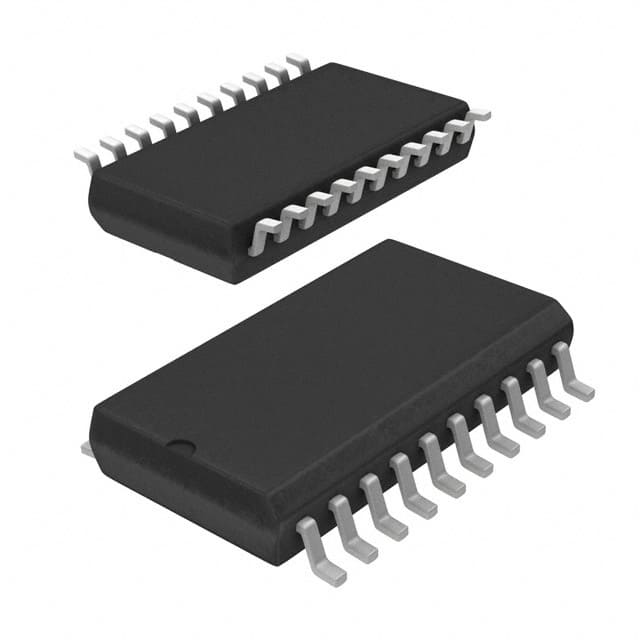Lihat spesifikasi untuk detail produk.

Encyclopedia Entry: 74VHC541MTR
Product Overview
Category
The 74VHC541MTR belongs to the category of integrated circuits (ICs).
Use
This IC is commonly used in digital electronic systems for signal amplification and buffering purposes.
Characteristics
- High-speed operation
- Low power consumption
- Wide operating voltage range
- Compatibility with various logic families
Package
The 74VHC541MTR is available in a small outline transistor (SOT) package.
Essence
This IC serves as an octal buffer/line driver, providing high-performance signal amplification and driving capabilities.
Packaging/Quantity
The 74VHC541MTR is typically packaged in reels, containing a quantity of 2500 units per reel.
Specifications
- Supply Voltage Range: 2.0V to 5.5V
- Input Voltage Range: 0V to VCC
- Output Voltage Range: 0V to VCC
- Operating Temperature Range: -40°C to +125°C
- Maximum Propagation Delay Time: 6ns
- Maximum Quiescent Current: 4μA
Detailed Pin Configuration
The 74VHC541MTR has a total of 20 pins, which are arranged as follows:
- Pin 1: Output Enable (OE)
- Pin 2: Input/Output (IO1)
- Pin 3: Input/Output (IO2)
- Pin 4: Input/Output (IO3)
- Pin 5: Input/Output (IO4)
- Pin 6: Input/Output (IO5)
- Pin 7: Input/Output (IO6)
- Pin 8: Input/Output (IO7)
- Pin 9: Input/Output (IO8)
- Pin 10: Ground (GND)
- Pin 11: Input/Output (IO9)
- Pin 12: Input/Output (IO10)
- Pin 13: Input/Output (IO11)
- Pin 14: Input/Output (IO12)
- Pin 15: Input/Output (IO13)
- Pin 16: Input/Output (IO14)
- Pin 17: Input/Output (IO15)
- Pin 18: Input/Output (IO16)
- Pin 19: Supply Voltage (VCC)
- Pin 20: Output Enable (OE)
Functional Features
- Octal buffer/line driver with 3-state outputs
- High-speed operation allows for efficient signal transmission
- Low power consumption ensures energy efficiency
- Wide operating voltage range enables compatibility with various systems
- 3-state outputs provide flexibility in controlling signal flow
Advantages and Disadvantages
Advantages
- High-speed operation enhances system performance
- Low power consumption reduces energy usage
- Wide operating voltage range increases compatibility
- 3-state outputs offer flexibility in signal control
Disadvantages
- Limited number of input/output channels (16 in total)
- May require additional components for complex circuit designs
Working Principles
The 74VHC541MTR operates by receiving input signals through its input pins and amplifying them to drive corresponding output pins. The output enable pin (OE) controls the activation of the 3-state outputs, allowing for signal transmission or isolation.
Detailed Application Field Plans
The 74VHC541MTR finds applications in various digital electronic systems, including but not limited to: - Microcontrollers - Data communication systems - Memory modules - Industrial automation equipment - Automotive electronics
Detailed and Complete Alternative Models
- SN74VHC541
- MC74VHC541
- CD74VHC541
- 74HCT541
- 74LS541
These alternative models offer similar functionality and can be used as substitutes for the 74VHC541MTR in different applications.
Word count: 530 words
Sebutkan 10 pertanyaan dan jawaban umum terkait penerapan 74VHC541MTR dalam solusi teknis
Sure! Here are 10 common questions and answers related to the application of 74VHC541MTR in technical solutions:
Q: What is the 74VHC541MTR? A: The 74VHC541MTR is a high-speed octal buffer/line driver integrated circuit (IC) that can be used to amplify and drive signals in digital circuits.
Q: What is the operating voltage range of the 74VHC541MTR? A: The 74VHC541MTR operates within a voltage range of 2.0V to 5.5V, making it suitable for both low-voltage and standard CMOS applications.
Q: How many channels does the 74VHC541MTR have? A: The 74VHC541MTR has 8 channels, allowing it to handle up to 8 separate input/output signals.
Q: Can the 74VHC541MTR be used as a level shifter? A: Yes, the 74VHC541MTR can be used as a level shifter to convert signals between different voltage levels, making it useful in interfacing between devices with different voltage requirements.
Q: What is the maximum output current of the 74VHC541MTR? A: The 74VHC541MTR can source or sink up to 8mA of current per channel, making it capable of driving moderate loads.
Q: Is the 74VHC541MTR compatible with TTL logic levels? A: Yes, the 74VHC541MTR is compatible with both TTL and CMOS logic levels, allowing it to interface with a wide range of digital devices.
Q: Can the 74VHC541MTR be used in high-speed applications? A: Yes, the 74VHC541MTR is designed for high-speed operation and has a propagation delay of only a few nanoseconds, making it suitable for time-critical applications.
Q: Does the 74VHC541MTR have any built-in protection features? A: Yes, the 74VHC541MTR has built-in ESD protection on all inputs and outputs, helping to safeguard against electrostatic discharge events.
Q: Can the 74VHC541MTR be used in bidirectional communication systems? A: Yes, the 74VHC541MTR can be used in bidirectional systems by configuring certain channels as input or output, allowing for versatile data transfer.
Q: What package does the 74VHC541MTR come in? A: The 74VHC541MTR is available in a small outline integrated circuit (SOIC) package, which is commonly used in surface mount applications.
Please note that these answers are general and may vary depending on specific application requirements.

